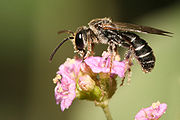
Sweat bee
Encyclopedia

Bee
Bees are flying insects closely related to wasps and ants, and are known for their role in pollination and for producing honey and beeswax. Bees are a monophyletic lineage within the superfamily Apoidea, presently classified by the unranked taxon name Anthophila...
s that are attracted to the salt in human sweat
SWEAT
SWEAT is an OLN/TSN show hosted by Julie Zwillich that aired in 2003-2004.Each of the 13 half-hour episodes of SWEAT features a different outdoor sport: kayaking, mountain biking, ice hockey, beach volleyball, soccer, windsurfing, rowing, Ultimate, triathlon, wakeboarding, snowboarding, telemark...
. In its strict application, the name refers to members of the Halictidae
Halictidae
Halictidae is a cosmopolitan family of the order Hymenoptera consisting of small to midsize bees which are usually dark-colored and often metallic in appearance...
, a large family of bees that are common in most of the world except Australia
Australia
Australia , officially the Commonwealth of Australia, is a country in the Southern Hemisphere comprising the mainland of the Australian continent, the island of Tasmania, and numerous smaller islands in the Indian and Pacific Oceans. It is the world's sixth-largest country by total area...
and Southeast Asia
Southeast Asia
Southeast Asia, South-East Asia, South East Asia or Southeastern Asia is a subregion of Asia, consisting of the countries that are geographically south of China, east of India, west of New Guinea and north of Australia. The region lies on the intersection of geological plates, with heavy seismic...
, where they are only a minor faunistic element. In the United States
United States
The United States of America is a federal constitutional republic comprising fifty states and a federal district...
, the common species are black, brown, red, or metallic green, and sometimes with yellow markings, and usually 1/4 to 1/2 inch (4-10 mm) in size. Their attraction to sweat makes them a nuisance, as they will sting if squeezed or squashed against one's flesh. Their sting is only rated a 1.0 on the Schmidt Sting Pain Index
Schmidt Sting Pain Index
The Schmidt Sting Pain Index is a pain scale rating the relative pain caused by different Hymenopteran stings. It is mainly the work of Justin O. Schmidt, an entomologist at the Carl Hayden Bee Research Center in Arizona...
, making it almost painless. However, individuals with allergies to any kind of insect stings should seek immediate medical attention. Pest control is not recommended due to their beneficial nature in pollination
Pollination
Pollination is the process by which pollen is transferred in plants, thereby enabling fertilisation and sexual reproduction. Pollen grains transport the male gametes to where the female gamete are contained within the carpel; in gymnosperms the pollen is directly applied to the ovule itself...
.
As with many common names, however, the term "sweat bee" is applied colloquially to different insects in different continents, despite its technical restriction to halictids. Thus, in Africa
Africa
Africa is the world's second largest and second most populous continent, after Asia. At about 30.2 million km² including adjacent islands, it covers 6% of the Earth's total surface area and 20.4% of the total land area...
and parts of Southeast Asia
Southeast Asia
Southeast Asia, South-East Asia, South East Asia or Southeastern Asia is a subregion of Asia, consisting of the countries that are geographically south of China, east of India, west of New Guinea and north of Australia. The region lies on the intersection of geological plates, with heavy seismic...
, the colloquial name is used to refer to what are technically known as stingless bees
Stingless bee
Stingless bees, sometimes called stingless honey bees or simply meliponines, are a large group of bees, comprising the tribe Meliponini . They belong in the family Apidae, and are closely related to common honey bees, carpenter bees, orchid bees and bumblebees...
, which are typically in the genus Trigona
Trigona (genus)
Trigona is the largest genus of stingless bees, formerly including many more subgenera than the present assemblage; many of these former subgenera have been elevated to generic status. There are approximately 150 species presently included in the genus, in 11 subgenera...
and its relatives (family Apidae
Apidae
The Apidae are a large family of bees, comprising the common honey bees, stingless bees , carpenter bees, orchid bees, cuckoo bees, bumblebees, and various other less well-known groups...
), and also have the habit of taking up salt from human perspiration. The European honey bee
European honey bee
The Western honey bee or European honey bee is a species of honey bee. The genus Apis is Latin for "bee", and mellifera comes from Latin melli- "honey" and ferre "to bear"—hence the scientific name means "honey-bearing bee"...
, Apis mellifera, also occasionally laps human perspiration, as will other bees on occasion.
External links
- Everything About the Sweat Bee - Description and photo of the sweat bee
- sweat bees on the UF / IFASInstitute of Food and Agricultural SciencesThe University of Florida’s Institute of Food and Agricultural Sciences is a federal-state-county partnership dedicated to developing knowledge in agriculture, human and natural resources, and the life sciences, and enhancing and sustaining the quality of human life by making that information...
Featured Creatures Web site

